
by Larry Williams | Aug 4, 2022

Dr. Bryan Unruh with robotic mower. Credit: UF/IFAS
With gas prices increasing, there are practical ways to reduce gasoline use in your own backyard.
There are electric, battery, solar powered and robotic (autonomous) lawnmowers. Do you remember the non-motorized reel mower? Or, you could use sheep. But, for the time being, most people have gasoline powered mowers. There are costs involved with mowing, including the cost of gas or diesel fuel.
Be smart as to where you grow grass. Use grass where it serves a purpose. Concentrate your efforts in growing grass where it will grow. It’s normal for lawns to decline in close proximity to large trees. As a lawn gives way to tree competition, do something else in that area. Use mulch under trees or plant shade tolerant plants.
Fertilize smart. Lawns need fertilizer. But, too much fertilizer, particularly too much nitrogen, results in excessive grass growth that requires more mowing.
Many homeowners overdo it with too much nitrogen and too little potassium. Fertilizers with the correct ratios of nitrogen to potassium will produce the right balance of shoot to root growth. Choose a fertilizer such as 15-0-15 or some similar analysis with some slow release nitrogen. Fertilize to produce adequate growth and the correct color. If your lawn is a healthy green and you’re mowing, mowing, mowing… why add more fertilizer?
Centipedegrass and bahiagrass will grow best with fewer problems when fertilized sparingly. This would be one or two light applications of fertilizer per year, or none at all if these grasses are performing well. St. Augustinegrass and zoysiagrass might get by on one spring application; however, it’s more common to apply a second time during summer.
Never apply more than the recommended amount of fertilizer per application. You can always split the total amount into two or more applications, which will produce more even growth and minimize sudden growth spurts.
Though it’s a popular practice, reconsider overseeding your lawn with ryegrass this fall. Weigh the desire to have a green lawn through winter with the extra time and costs (gas, fertilizer, water and pesticides) involved with maintaining it.
Finally, keep your gas-powered lawnmower in good working condition. It can make a difference in how efficiently it operates. Make sure the equipment is clean. Change the oil if needed. Replace or clean the air filter and spark plug. Keep lawnmower blades sharp. Basically, follow the owner’s manual for routine maintenance.
Implementing these ideas can help conserve fuel and result in a healthier lawn.
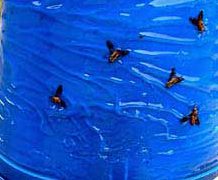
by Larry Williams | Jun 9, 2022
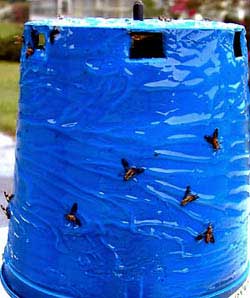
Deer fly trap. Photo credit: Russ Mizell
Recently, I’ve been asked about a deer fly trapping method that I wrote about a number of years ago. So, here it is. This aggravating insect is active now.
Deer flies, which are in the horsefly family, are annoying as they repeatedly and persistently dive for their victims until they inflict a painful bite.
Dr. Russ Mizell, now retired UF/IFAS Extension entomologist, experimented with a method to trap this insect. Mizell wanted to identify the optimum shape, size, color and speed to attract deer flies. If successful, he could temporarily remove a deer fly population long enough to enjoy an outdoor gathering without being bothered by deer flies.
Mizell said he started the research as a high school science project with his son but “it got so interesting, I just kept doing it.”
Deer flies wait for prey to walk before attacking. So, they are highly attracted to movement.
With this in mind, Mizell and his son decided the best way to snare deer flies was to “troll” for them from a slow-moving vehicle. Working in spring and summer when deer flies are most prominent, they set out to discover what kind of trap worked best.
They built a test platform on the hood of their vehicle that could troll seven different shapes at once. They ambled along in deer fly-infested countryside for set periods of one to five minutes, testing pyramids, squares, balloons, plant containers and other shapes, all coated with Tanglefoot (commercially available sticky spray for insects), then counting immobilized prey. They tried black, tan, blue and shapes of other colors suspended from various heights.
The trap that enticed the most deer flies proved to be a 6-inch flowerpot painted bright blue and coated with Tanglefoot. This trap captured as many as 30 deer flies in a one-minute test. It worked best when suspended three to six feet above the ground and trolled no faster than 10 feet per second or about 7 miles per hour.
The traps are remarkably effective, Mizell said. “Many times, after running the traps through an area, we found there were no deer flies left,” he said. “You trap them out for a short period until they repopulate the area.”
The traps also work when attached to a baseball cap and trolled by the hat’s wearer. But instead of attaching a flowerpot to your cap, you could attach a blue drink cup painted with Tanglefoot.
Despite its effectiveness, its aesthetic appeal leaves something to be desired.
For more information including instructions and pictures of how to make a deer fly trap visit the below site. http://entomology.ifas.ufl.edu/pestalert/deerfly.htm

by Larry Williams | Apr 28, 2022
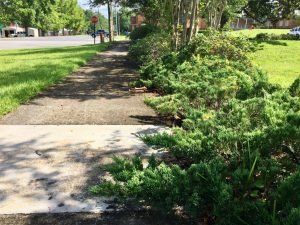
Misplaced junipers growing over sidewalk. Photo credit: Larry Williams
A number of years ago, I had the opportunity to speak at the International Flower and Garden Festival at Epcot in Orlando. I provided eight presentations on the topic “Right Plant, Right Place.”
The audiences consisted of people mostly from Florida but there were attendees from other parts of the U.S. and even from other countries. I started each presentation with the question, “Do any of you have all the right plants in all the right places in your landscape?” Not a single hand was raised in response to this question.
Most people do not have all the right plants in all the right places in their landscapes, including myself. Hopefully, no one is on the other extreme of having all the wrong plants in all the wrong places, either.
Most people fall somewhere in between these two extremes. As a Florida gardener, you’d be wise to better implement this idea into your landscape.
Right plant, right place does require some knowledge of your property’s site conditions and knowledge of plants to be used on the site. The main idea is to best match the plants to the existing site conditions.

Misplaced large oak tree that needs more root space. Photo credit: Larry Williams
How often do we place shade loving plants in full sun or poor salt tolerant plants along the coast or plants that are native to wet areas such as wax myrtles on deep sandy, dry sites? These misplaced plants will not be “happy” and eventually will have problems.
How often do we take a plant in a gallon size container, plant it under a low window and expect it to stay the same size? Or, what about the sixty-foot tree under a twenty-foot power line. Plants are designed to grow.
Find out the mature size, in height and width, and place the plant where it has plenty of room to develop into its mature size.
Right plant, right place involves choosing plants that will standup to our wind, climate, humidity, heat, rain, winter weather, etc. Certain plants such as tulip and lilac don’t perform well here because of the lack of sufficient cold weather and the fact that it becomes too hot too early. But we can grow other flowering bulbs such as amaryllis and other flowering shrubs and trees such as crape myrtle and chaste tree.
With some planning and forethought in selecting and placing plants, your Florida landscape can be aesthetically pleasing, easier to maintain and more Florida-friendly.
For additional information on selecting the right plants for your landscape, contact the UF/IFAS Extension Office in your county or visit the below website https://ffl.ifas.ufl.edu.

by Larry Williams | Mar 24, 2022
Calibrating or determining the rate of water your sprinkler system applies is an easy job.
Here’s how to do it:
- Obtain 5 to 10 straight-sided empty cans such as tuna fish or soup cans.
- Place the containers randomly within the irrigated area so that they catch the water when the irrigation system is running. This needs to be done for each irrigation zone, separately.
- Turn the water on for 15 minutes.
- Use a ruler to measure the depth of water in each can. The more exact your measurement, the better your calibration will be. Measurements to the nearest 1/8 inch are adequate.
- Determine the average depth of water collected in the cans (add up the depths of water measured in each can and then divide by the number of cans).
- To determine the irrigation rate in inches per hour, multiply the average depth of water times four. For example, if you collected an average of ¼ inch of water in the cans as a result of letting the irrigation run for 15 minutes, the irrigation zone would need to run for 30 minutes to apply ½ inch of water, or 45 minutes to apply ¾ inch of water, etc.
It’s best to do this calibration exercise during the same time of day the system normally runs so that water pressures are similar.
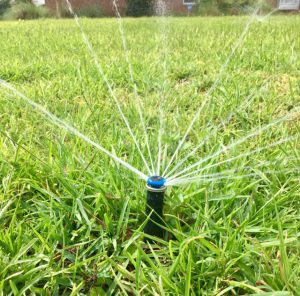
Irrigating lawn. Photo credit: Larry Williams
Here’s why calibrating your system is important.
When a timer/controller is set to come on frequently for short intervals of time (every other day for 20 minutes for example), the result will be a shallow, weak root system and a lawn that becomes dependent on its shallow roots being watered frequently. Also, watering frequently benefits certain weeds such as dollarweed and nutsedge while weakening the lawn.
To develop a deep, strong root system and a lawn that will go through hot, dry weather in better shape without requiring water as often, switch the automatic timer to manual.
Watering a lawn on an as needed basis is the best way to water correctly and develop a deep-rooted lawn. This is the reason for calibrating your irrigation system. You should apply ½ to ¾ inch of water to the lawn only when the grass indicates that water is needed. When the grass needs water, the leaf blades fold along the midrib (like a book closing). Also, footprints or tire tracks remain in the lawn long after being made. And, the lawn turns grayish in spots, indicating it needs water.
When 30 to 40 percent of the lawn shows these signs of water need, turn the irrigation system on and let it run long enough to apply ½ to ¾ inch of water. Don’t water again until the lawn begins to show these signs of water need. Don’t water when adequate rain has occurred.
The best time to observe these signs of water need is during the evening when the grass is not in full sun or under heat stress. It’s best to irrigate during early morning hours to prevent lawn diseases and to minimize water lose due to wind and evaporation. The lawn grass is a great indicator for when most other established plants in a landscape need water as well.

by Larry Williams | Feb 10, 2022
February can be a confusing month for North Florida gardeners. Winter isn’t over. So, don’t let spring fever cause you to make some gardening mistakes. Let’s take a look at some dos and don’ts of February gardening.
Despite colder temperatures that we can experience this month, it’s still okay to plant trees and shrubs from containers. The roots are better protected in the ground and will quickly grow outward to establish as compared to being exposed to cold temperatures above ground, confined in a container. But be cautious about planting cold sensitive tropical plants too soon while freezing weather is likely. Bare-root trees and shrubs should be in the ground promptly. This includes bare-root nut and fruit trees, pine and hardwood tree seedlings and bare-root roses. Dormant season planting allows time for establishment before hot weather arrives.
February is a good time to transplant or move trees and shrubs that are in the wrong place. Consider moving plants that require pruning to force them to “fit” into small or confined spaces. Move them to an appropriate location where they can grow to full size. Then you can plant something new and appropriately sized for replacement. Of course, they need to be reasonable in size to move.
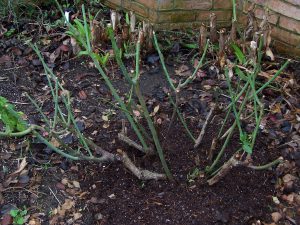
Bush rose plant correctly pruned. Photo credit: Matt Orwat
Late February is a good time to prune overgrown shrubs such as ligustrum and holly. These plants usually respond well to severe pruning, if necessary. But remember, they will eventually regrow to their larger size. Prune to shape and thin broadleaf evergreens and deciduous flowering trees such as oleander, crape myrtle and vitex. Avoid severely pruning narrow leaf evergreens such as junipers because they have few buds on old wood from which to form new growth. Mid-February is a good time to prune bush roses, removing dead or weak canes. Leave several healthy canes and cut these back to about eighteen inches. Delay doing much pruning on early spring flowering shrubs such as azalea until shortly after they flower. Pruning these plants now will remove present flower buds before they can open. Prune deciduous fruit trees such as peach, plum and apple. Now is also the time to prune ornamental grasses such as muhly grass.
If your lawn has a history of problems with summer annual weeds such as crabgrass, apply a preemergence herbicide. This should be done February 15 to March 1 when day temperatures reach 65° to 70°F for 4 or 5 consecutive days. A second application may be needed eight weeks later. Many people fertilize their lawns too early. Wait until mid-April to fertilize to prevent lawn injury and for the most efficient use of the fertilizer.











